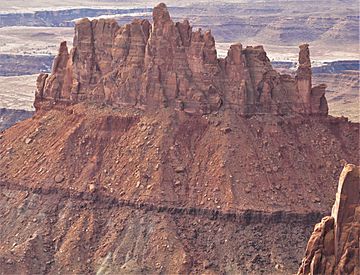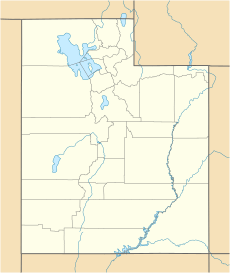Tiki Tower facts for kids
Quick facts for kids Tiki Tower |
|
|---|---|

Tiki Tower to right, north aspect
|
|
| Highest point | |
| Elevation | 5,500 ft (1,700 m) |
| Prominence | 160 ft (49 m) |
| Isolation | 0.09 mi (0.14 km) |
| Parent peak | Point 5601 |
| Geography | |
| Location | Canyonlands National Park San Juan County, Utah, U.S. |
| Parent range | Colorado Plateau |
| Topo map | USGS Musselman Arch |
| Geology | |
| Age of rock | Late Triassic |
| Type of rock | Wingate Sandstone |
| Climbing | |
| First ascent | 1991 |
| Easiest route | class 5.9 A1 Climbing |
Tiki Tower is a tall, thin rock formation in Canyonlands National Park, Utah. It stands about 300-foot (91-meter) high. This amazing natural tower is found in the "Island in the Sky" area of the park. It is located in San Juan County, Utah.
Tiki Tower is made of a type of rock called Wingate Sandstone. This sandstone formed from ancient sand dunes. These dunes were blown by the wind about 200 million years ago. This was during a time called the Late Triassic period. The tower is about half a mile northwest of Airport Tower.
You can reach Tiki Tower by driving on the White Rim Road. This road is only for vehicles with four-wheel drive. The top of the tower rises 1,100 feet above the road. Water from rain and snow flows from Tiki Tower. It drains into the nearby Colorado River. This water travels through Buck and Lathrop Canyons.
Climbing Tiki Tower
People enjoy climbing Tiki Tower. The first time anyone climbed it was in November 1991. The climbers were Jeff Widen and Mitch Allen. They used a route called Brave Little Toaster. This climb is rated as 5.11 and has three sections, called pitches. Fred Lifton and Paul Frank helped with the first part of the climb.
Weather at Tiki Tower
The best times to visit Tiki Tower are in spring and fall. The weather is usually mild and pleasant then. The area has a Cold semi-arid climate. This means it's a desert climate. The coldest month has an average temperature below 0 °C (32 °F).
This desert area gets less than 10 inches (250 millimeters) of rain each year. Most of this rain falls in spring and summer. Snowfall is usually light during the winter months.



